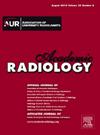A CT-Based Clinical-Radiomics Nomogram for Predicting the Overall Survival to TACE Combined with Camrelizumab and Apatinib in Patients with Advanced Hepatocellular Carcinoma
IF 3.8
2区 医学
Q1 RADIOLOGY, NUCLEAR MEDICINE & MEDICAL IMAGING
引用次数: 0
Abstract
Rationale and Objectives
To construct a computed tomography (CT)-based clinical-radiomics nomogram for estimating overall survival (OS) in advanced hepatocellular carcinoma (HCC) patients receiving transcatheter arterial chemoembolization (TACE) in combination with camrelizumab and apatinib.
Methods
A retrospective recruitment of 150 patients with clinically or pathologically confirmed HCC was conducted, followed by their division into training cohort (n = 105) and test cohort (n = 45). To generate the radiomics score (Rad-score), a series of analyses were performed, including Pearson correlation analysis, univariate Cox analysis, and least absolute shrinkage and selection operator Cox regression analysis. Subsequently, a clinical-radiomics nomogram was constructed using the Rad-score combined with independent clinical prognostic factors, followed by assessments of its calibration, discrimination, reclassification, and clinical utility.
Results
Five CT radiomics features were selected. The Rad-score showed a significant correlation with OS (P < 0.001). The clinical-radiomics nomogram demonstrated superior performance in estimating OS, with a concordance index (C-index) of 0.840, compared to the radiomics nomogram (C-index: 0.817) and the clinical nomogram (C-index: 0.661). It also exhibited high 1-year and 2-year area under the curves of 0.936 and 0.946, respectively. Additionally, the clinical-radiomics nomogram markedly enhanced classification accuracy for OS outcomes, as evidenced by net reclassification improvement and integrated discrimination improvement. Decision curve analysis confirmed its clinical utility.
Conclusion
A CT-based clinical-radiomics nomogram exhibits strong potential for predicting OS in advanced HCC patients undergoing TACE combined with camrelizumab and apatinib.
预测晚期肝细胞癌患者TACE联合康瑞珠单抗和阿帕替尼总生存期的基于CT的临床放射组学提名图
原理和目的:构建基于计算机断层扫描(CT)的临床放射组学提名图,用于估计接受经导管动脉化疗栓塞术(TACE)联合坎瑞珠单抗和阿帕替尼治疗的晚期肝细胞癌(HCC)患者的总生存期(OS):回顾性招募了150名临床或病理确诊的HCC患者,然后将其分为训练队列(105人)和测试队列(45人)。为了得出放射组学评分(Rad-score),进行了一系列分析,包括皮尔逊相关分析、单变量 Cox 分析、最小绝对缩小和选择操作者 Cox 回归分析。随后,利用Rad-score结合独立的临床预后因素构建了临床放射组学提名图,并对其校准、鉴别、再分类和临床实用性进行了评估:结果:选出了五个 CT 放射组学特征。结果:选出了五个CT放射组学特征,Rad-score与OS有显著相关性(P 结论:Rad-score与OS有显著相关性(P 结论):基于CT的临床放射组学提名图在预测接受TACE联合康瑞珠单抗和阿帕替尼治疗的晚期HCC患者的OS方面具有很强的潜力。
本文章由计算机程序翻译,如有差异,请以英文原文为准。
求助全文
约1分钟内获得全文
求助全文
来源期刊

Academic Radiology
医学-核医学
CiteScore
7.60
自引率
10.40%
发文量
432
审稿时长
18 days
期刊介绍:
Academic Radiology publishes original reports of clinical and laboratory investigations in diagnostic imaging, the diagnostic use of radioactive isotopes, computed tomography, positron emission tomography, magnetic resonance imaging, ultrasound, digital subtraction angiography, image-guided interventions and related techniques. It also includes brief technical reports describing original observations, techniques, and instrumental developments; state-of-the-art reports on clinical issues, new technology and other topics of current medical importance; meta-analyses; scientific studies and opinions on radiologic education; and letters to the Editor.
 求助内容:
求助内容: 应助结果提醒方式:
应助结果提醒方式:


